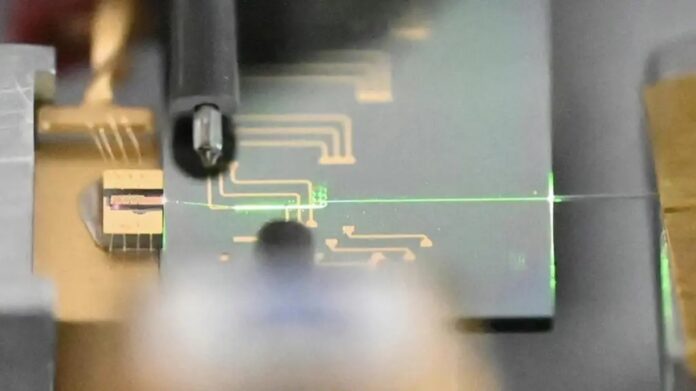Mode-locked lasers offer a platform to generate ultra-brief coherent light pulses and precisely spaced light frequency combs, making them an enabling technology in the ultrafast sciences. Usually, these lasers are large and heavy, with their parts resting on an optical table.
Researcher Qiushi Guo demonstrates a novel approach for creating high-performance ultrafast lasers on nanophotonic chips. He shrunk a mode-locked laser down to the size of an optical chip.
However, realizing an efficient mode-locked laser on a chip is a challenging task. The study uses a thin-film lithium niobate (TFLN), an innovative material platform. With this material, laser pulses may be precisely controlled and shaped effectively by adding an external radio frequency electrical signal. Guo’s group demonstrated a laser with a high output peak power of 0.5 Watts by smartly combining the strong laser gain of III-V semiconductors with the effective pulse-shaping ability of TFLN nanoscale photonic waveguides.
In addition to being compact, the exhibited mode-locked laser has numerous exciting characteristics. For instance, Guo could precisely tune the repetition frequencies of out pulses in an extensive range of 200 MHz by varying the laser’s pump current. Using the laser‘s great reconfigurability, the research team expects to make frequency-stabilized chip-scale comb sources possible—a necessary tool for precise sensing.
Researchers have cleared a significant hurdle with this latest demonstration. Still, researchers are now looking forward to addressing additional obstacles to developing scalable, integrated, ultrafast photonic systems that may be translated for usage in portable and handheld devices.
Guo said, “This achievement paves the way for eventually using cell phones to diagnose eye diseases or analyzing food and environments for things like E. coli and dangerous viruses.”
“It could also enable futuristic chip-scale atomic clocks, which allows navigation when GPS is compromised or unavailable.”
Scientists have cleared a significant hurdle with this latest demonstration. Still, scientists are now looking forward to addressing additional obstacles to developing scalable, integrated, ultrafast photonic systems that may be translated for usage in portable and handheld devices.
Journal Reference:
- Qiushi Huo, Benjamin Gutierrej, RYoto Sekine et al. Ultrafast mode-locked laser in nanophotonic lithium niobate. Science. DOI: 10.1126/science.adj5438
